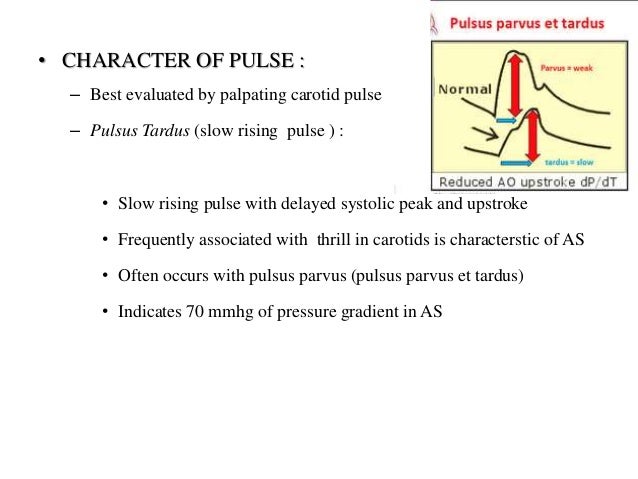- Pulsus Group, the medical peer-review publisher, publishes the work of medical researchers in a manner that exemplifies the highest standards in research integrity. Endorsed by medical societies, Pulsus Group is an ardent supporter of international medical research, and publishes the following journals directed at a broad range of physician.
- Pulsus tardus et parvus, also pulsus parvus et tardus, slow-rising pulse and anacrotic pulse, is weak (parvus), and late (tardus) relative to its expected characteristics. It is caused by a stiffened aortic valve that makes it progressively harder to open, thus requiring increased generation of blood pressure in.
- Definition A fall of systolic blood pressure of 10 mmHg during the inspiratory phase Pathophysiology (result of the following mechanisms operating alone or in combination) Limitation in increase in.

Pulsus Parvus et Tardus Symptom Checker: Possible causes include Aortic Valve Stenosis. Check the full list of possible causes and conditions now! Talk to our Chatbot to narrow down your search.
Click to see full answer
Moreover, how can I check Pulsus Parvus et Tardus?
To assess for 'tardus,' auscultate the patient's S2 heart sound while palpating their carotid upstroke. The S2 and carotid upstroke should occur almost simultaneously. If the carotid upstroke comes significantly after the S2 heart sound, 'tardus' is present indicating severe aortic stenosis.
Likewise, what is Bisferiens pulse? Pulsus bisferiens, also known as biphasic pulse, is an aortic waveform with two peaks per cardiac cycle, a small one followed by a strong and broad one. It is a sign of problems with the aorta, including aortic stenosis and aortic regurgitation, as well as hypertrophic cardiomyopathy causing subaortic stenosis.
Also Know, what is carotid upstroke?


Definition. The carotid pulse is characterized by a smooth, relatively rapid upstroke and a smooth, more gradual downstroke, interrupted only briefly at the pulse peak. These palpable pulsatile changes in the carotid arterial diameter are virtually identical to the intraluminal pressure pulse.
How does aortic stenosis sound?
Aortic Stenosis AuscultationThis is often a loud murmur heard early in systole. It has a diamond shaped appearance when viewed on the phonocardiograph, which is heard when the murmur rises in sound intensity. The murmur is characterized by regular vibrations which give the murmur a musical quality ('cooing').
Also found in: Wikipedia.
pulsus
[pul´sus] (L.)Pulsus Parvus Et Tardus Aortic Stenosis
pul·sus par·'vus et tar·'dus

Pulsus Parvus And Pulsus Tardus
Want to thank TFD for its existence? Tell a friend about us, add a link to this page, or visit the webmaster's page for free fun content.
Link to this page:

Pulsus Parvus

Comments are closed.